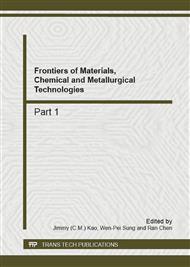p.944
p.949
p.954
p.958
p.962
p.969
p.975
p.983
p.988
Decontamination of Drilling Fluid Waste from Coalbed Methane Well
Abstract:
Coalbed methane drilling can produce drilling fluid waste, and inappropriate treatment will influence the environment and subsequent operation. Because of the scattered coalbed methane well locations and cost reasons, domestic and foreign conventional oil and gas drilling fluid waste method cannot be copied. So the solidified method is more appropriate. Referencing the region of Lin Fen, by detecting five wells’ waste drilling fluid indoor, the indexes are pH, coloration, suspended matter, BOD5, COD, total chromium and hexavalent chromium. The drilling fluid index of waste-polymer is beyond the Grade-2 National Wastewater Discharge Standards, but the waste Fuzzy-Ball based drilling fluid reach the standards. It has been designed indoor that the formula of waste Fuzzy-Ball based drilling fluid solidified method’s which is mainly based on cement. The indexes of leaching solution are pH, coloration, suspended matter(99mg/l), BOD5(52.3mg/l), COD(117.4mg/l), total chromium(0.32mg/l), hexavalent chromium(0.13mg/l) and the leaching solution can reach the Grade-2 National Wastewater Discharge Standards. Solidification mud can achieve without large appliance and can deal with 200m3 waste Fuzzy-Ball based drilling fluid of JU2-H well in 10 days, its indexes of leaching solution can reach the Grade-2 National Sewage Discharge Standards. The strengths must be sure for the later vehicle transporting and the cultivation after land fill. Using Fuzzy-Ball based drilling fluid when drill can ensure the source controlling of waste drilling fluid pollution. At the same time, it can cost lower and operate easier.
Info:
Periodical:
Pages:
962-968
Citation:
Online since:
October 2012
Authors:
Price:
Сopyright:
© 2012 Trans Tech Publications Ltd. All Rights Reserved
Share:
Citation:


